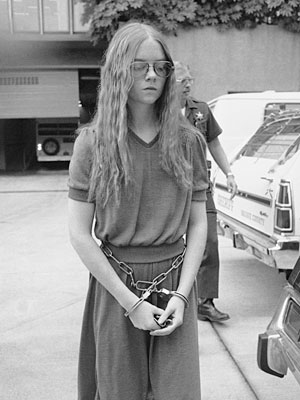“Ugh, it’s Monday” are the words that usually follow the arrival of the most dreaded day of the week. The sighs floating in the air are palpable and nothing seems possible. Mondays always carry with them a negative connotation and contain components such as depression, fatigue, and anguish. But to a San Diego elementary school, and to a troubled sixteen year old, Monday, January 29, 1979 held an even more distressing meaning.

Students at Grover Cleveland Elementary School, located in San Diego, California, began what they believed would be a normal Monday morning like any other, with bells ringing and students racing to their classes. Little did they know, however, that across the street, sixteen-year-old Brenda Ann Spencer was aiming her .22 caliber semiautomatic rifle right at society’s ultimate refuge, the elementary school, and its surroundings. After the first bell rang, Brenda broke the panels on the front door of her home, which was located right across the street from the elementary school. And she began to fire. The school’s principal, Burton Wragg, while rushing outside, was hit on the shoulder and chest with Spencer’s bullets and eventually died. Michael Suchar, the school’s custodian, ran outside with a blanket in order to cover Wragg and keep him from going into shock, but he quickly became the second victim of Spencer’s shooting and lost his life. In between all the chaos, 28 year old Robert Robb, a recent graduate of the police academy, while examining Wragg’s and Suchar’s bodies, was shot under his right shoulder blade.1 He would go on to survive though, along with the eight other children who were wounded in the incident. At least three of those children had abdominal wounds. A nine-year-old student, Cam Miller, was struck in the back with a bullet that exited through his chest without hitting any internal organs. Another, Christy Buell, was shot through her abdomen and in the buttocks, and had to undergo surgery in order to repair her intestine.2
When Gus Stevens, a reporter for the San Diego Evening Tribune, began calling around the area to gain more information about the shooting, he coincidentally placed a call to Spencer’s home where she gave him exactly what he wanted. She described the shooter, a sixteen year old, and the shooter’s address. When Stevens realized that she gave him her own address, he recognized what was going on and requested an interview while another staff member informed the police of the situation. The police, now aware of where the shots were coming from, were able evacuate the children and obstruct Spencer’s line of sight while trying to negotiate with her. After several hours, Brenda Spencer surrendered her weapon and several rounds of ammunition, and was subsequently arrested. While on the phone with Stevens, Spencer had stated that she was just shooting for the “fun of it.” She went on to say that she just didn’t like Mondays and did this “because it’s a way to cheer up the day.”3

Contrary to her initial claim, she later went on to state in her 2001 parole hearing that she had been “sexually abused by [her] father” and was “waiting for the cops to show up so they could shoot [her].”4 This new information has fueled many more theories today about Brenda Spencer’s true motives in committing such a crime. During her pretrial psychological testing, an injury to Spencer’s temporal lobe came to light. Spencer has also stated in a letter from prison that she experiences “grand mal seizures” that she has to counteract with medications.5 Such a brain injury would definitely be a precursor to epilepsy, which is two to four times more common among violent offenders than the public.6 The lack of treatment she received for this disease, to some, proves the neglect that she experienced from her family and in her childhood. Psychologist Jonathan Fast introduces the idea that her brain injury, abuse, and the effects of it pushed her to her final actions. He believes that the shame, ridicule, inferiority, and powerlessness that she felt encouraged her to go as far as she did. In another letter she wrote in prison, she stated that her “father had done everything a person could do to another person. The beatings, the touching, the emotional abuse.” She went on to state that no one, not teachers or counselors, gave her assistance through this, so she simply thought that this was how the world and how life worked. When her father gifted her the .22 caliber rifle, she thought that he was finally telling her to do it: to take her life successfully, unlike her past suicide attempts, and leave the world forever.7
Whether these theories are true or not, Brenda Spencer was tried as an adult and pleaded guilty to two counts of murder and nine counts of assault. She was sentenced to twenty-five years to life in prison, and is still serving her sentence at the California Institute for Women. The shooting has inspired a song by the Boomtown Rats called “I Don’t Like Mondays,” and has also gained other media coverage through a documentary.8 Her action went down in history as the first high profile school shooting and has become a vanguard to many future, unimaginable school situations and violent outbreaks. Whether Spencer was a cold-hearted killer or a truly lost and confused soul that simply wanted an escape, it is undeniable that her horrible actions have had some frightening consequences in our modern world.
- Jonathan Fast, Ceremonial Violence (New York: The Overlook Press, 2008), 25, 70-71. ↵
- Tamara Jones, “Look Back in Sorrow,” Good Housekeeping 227, no.5 (November 1998): 118. ↵
- Jonathan Fast, “Unforgiven and Alone: Brenda Spencer and Secret Shame,” in School Shootings: International Research, Case Studies, And Concepts For Prevention, ed. Nils Böckler (New York: Springer, 2013), 253-255. ↵
- Debra Sevey, “Subsequent Parole Consideration Hearing of Brenda Spencer,” (Capitol Electronic Reporting, 2001), 15-16. ↵
- Jennifer Furio, Letters From Prison: Voices Of Women Murderers (New York: Algora Pub., 2001), 134. ↵
- Jonathan Fast, ” Unforgiven and Alone: Brenda Spencer and Secret Shame,” in School Shootings: International Research, Case Studies, And Concepts For Prevention, ed. Nils Böckler (New York: Springer, 2013), 251. ↵
- Jennifer Furio, Letters From Prison: Voices Of Women Murderers (New York: Algora Pub., 2001), 134-135. ↵
- Encyclopedia of School Crime and Violence, September 2011, s.v. “Brenda Spencer,” by Laura L. Finley. ↵



243 comments
Cristianna Tovar
It’s crazy to think that such a young girl would want to take many children’s lives. It was truly disgusting to read that Brenda Spencer said she started shooting at people just “for the fun of it,” and even said that it was her way of cheering up the day. However, I did suspect that she had a troubled childhood, and my suspicions were proven to be true since she had later said that she had been sexually abused by her father. I thought it was odd that her father had gifted her a .22 caliber rifle for her birthday because maybe he was trying to tell her to take her own life. As sad as this story is, the author does a great job of educating their readers about how traumatizing experiences affect the way that people feel about the world.
Audrey Uribe
This is my first time hearing of this case. I’m shocked with every component of the story. Mental health is a serious issue and there needs to be more awareness towards it. The excuse of ” she didn’t like Mondays” is absolutely insanity. The fact that her only “way out” was to be a school shooter is a tragedy. This case makes me sad.
Amanda Quiroz
I get that mental illness is a problem and I support people who struggle with it 100% but I don’t see it as an excuse to commit such crimes like this. It’s scary that the world has come to shooting others for the “fun of it”. School is one place where a child should feel safe when they’re not at home. It’s sad that things have come to this.
Ashley Martinez
This was a heartbreaking article to read about because there were innocent elementary age children and staff members that were injured and killed. Brenda Spencer seemed to have a troubled childhood which more than likely led to this event but that is not an excuse for physically harming other people. School shootings are happening more and more frequently which is awful. It is typically seen that these people pulling off these shootings are suffering with mental illnesses. Guns do not kill people, people kill people. The guns need someone to pull the trigger, and I feel we should have stricter gun safety laws.
Vanessa Quetzeri
I have never heard of someone having such a bad Monday, so bad, that she shot at an elementary school. It’s mind-blowing to think that someone would shoot up a school, especially a school attended primarily by children. To this day, it could still be argued whether or not she was mentally disturbed or just plain psychotic, but at the end of the day people still lost their lives and many children were injured.
Amelia Hew
True, Spencer had a difficult childhood, suffering from a mental illness and was abused by her father. However, I believed that this was no excuse for her crimes as she clearly know what she was doing. Her reason for the shooting she gave to the police is just ridiculous. Perhaps she just wanted to be taken away, or maybe she is just done, fed up with everything and finally snapped.
Rahni Hingoranee
It is very sad to hear that someone would even think that this a way to make a statement. Spencer was clearly psychologically troubled, majorly. The fact that her father gifted her a gun after knowing her history with suicide attempts is equally disturbing. Any parent who abuses their child is truly disgusting. The acts she committed were inexcusable. She had to have known a less fatal way to make a statement, she does deserve her sentence.
Stephanie Cerda
She was very aware of her actions. By giving out her own address, and calling herself, she showed this. It’s crazy to think that after so many years, this type of things are still happening. Although her history of illnesses is long, that doesn’t excuse her actions because she was perfectly aware. She wasn’t delusional, or anything like that. Her actions still affected the world, and people are gone because of her. It’s sad to hear that she didn’t receive any help, though. Maybe that would have changed things.
Priscilla Poorbaugh
It is always so common for people who have had a troubled childhood to become killers, not that it justifies anything. She committed such a terrible act and it was to innocent elementary school kids. I really do think that she wanted a “murder- suicide” because she actually called the cops on herself and wanted them to come and find her.
Briana Montes
Its so sad to see such young kids doing terrible things like this. Especially when they are most likely not in the right state of mind. She was a sad, abused, young girl. Its so sad that lives were taken in this tragic event and she will always remember that, as well as the kids that were there. Probably traumatized because of this. Its scary because it can happen at anytime.